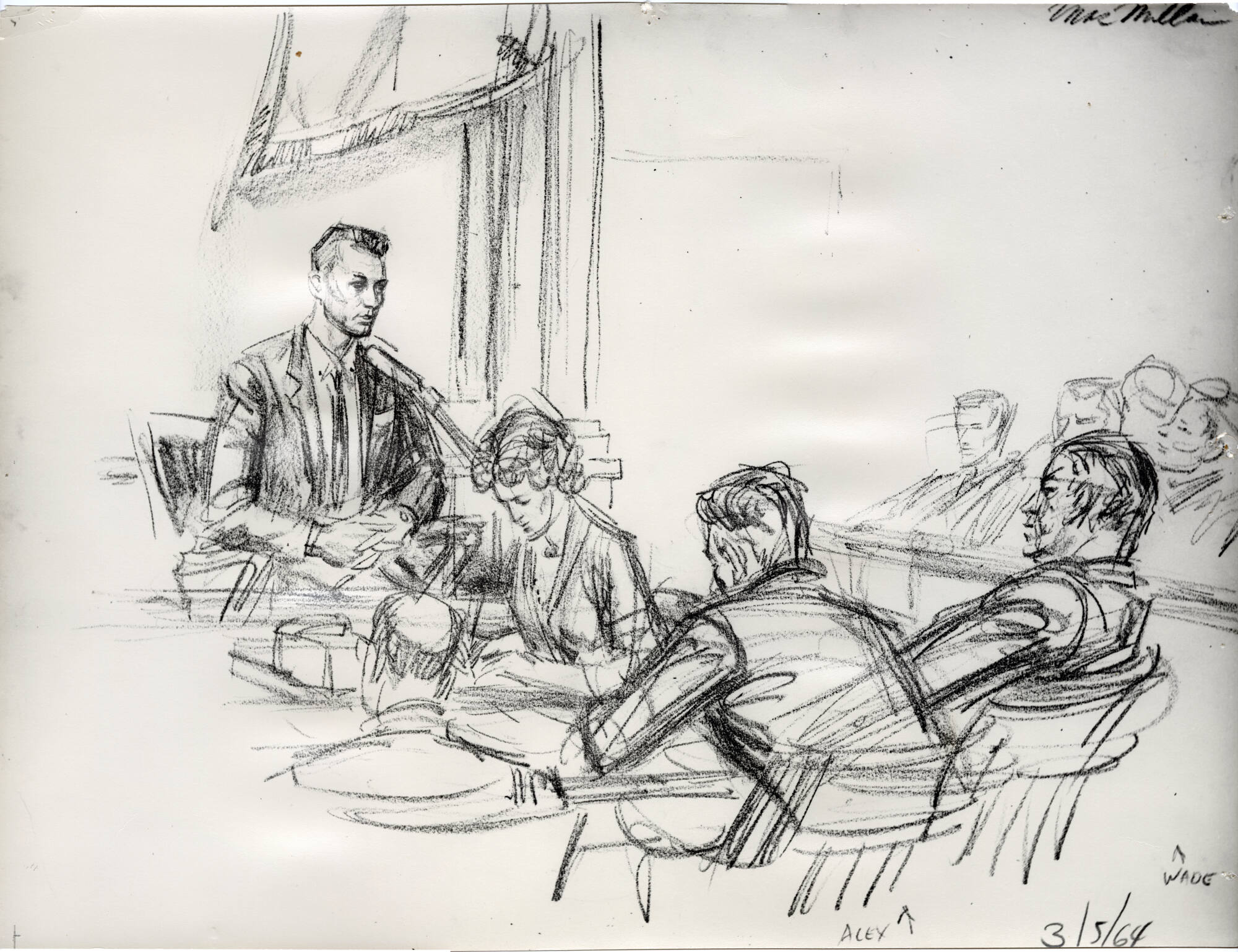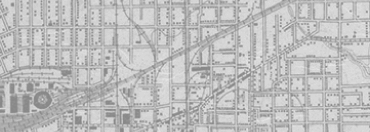


Back
Photograph of courtroom sketch of witness T. D. McMillon at Jack Ruby trial
Photograph of courtroom pencil sketch on paper by CBS News courtroom artist Howard Brodie. The sketch shows witness T.D. McMillon testifying during the Jack Ruby trial on March 5, 1964. The sketch shows McMillon sitting on the witness stand in front of a microphone. Seated directly in front of McMillon is a woman, likely the courtroom reporter. In the foreground, with their backs to the viewer are three figures seated at the prosecution attorney's table. From left to right are attorney Frank Watts, Assistant District Attorney Bill Alexander, and District Attorney Henry Wade. Handwritten captions along the upper and bottom edges of the image read "MacMillan" and "Alex / 3/5/64 / Wade." Two small arrows next to the names "Alex" and "Wade" point to the respective figures. Brodie made the original pencil sketches for CBS News during the trial of Jack Ruby after the judge barred cameras from the courtroom. Brodie then gave Joe Tonahill this photograph of a courtroom sketch as part of a collection of more than 40 in 1964.
Photograph of courtroom sketch of witness T. D. McMillon at Jack Ruby trial
03/05/1964
Paper
14 5/8 × 19 5/16 in. (37.1 × 49.1 cm)
Tonahill Family Partners Collection/The Sixth Floor Museum at Dealey Plaza
2014.034.0011
Howard Brodie (1915-2010) was a sports artist for the San Francisco Chronicle when he enlisted in the U.S. Army with America's entry into World War II. He ultimately became one of the best-known sketch artists of the war, frequently published in the weekly U.S. military magazine, Yank, which ran from June 1942 to December 1945. After the war, Brodie spent the next thirty-five years as a courtroom artist, attending several notable trials including the Chicago Seven, Charles Manson and, of course, the Jack Ruby trial in 1964. For the Ruby trial, Brodie worked as a CBS-TV artist correspondent. Mr. Brodie recorded an oral history with the Museum in 2006. -- Stephen Fagin, Curator
A Dallas police auto theft detective, Thomas McMillon offered some particularly damaging testimony against Jack Ruby. He said that Ruby yelled out, "You rat son of a bitch, you shot the president," just before firing his gun into Oswald's stomach. Furthermore, according to McMillon, Ruby later admitted that he had meant to shoot Oswald three times but said that police officers had moved too fast and stopped him from firing more than one shot. These statements damaged Melvin Belli's defense claim that Ruby was in a fugue state and unaware of his actions at the moment of the Oswald shooting. It also suggested premeditation. -- Stephen Fagin, Curator

Photograph of courtroom sketch of witness T. D. McMillon at Jack Ruby trial
Photograph of courtroom pencil sketch on paper by CBS News courtroom artist Howard Brodie. The sketch shows witness T.D. McMillon testifying during the Jack Ruby trial on March 5, 1964. The sketch shows McMillon sitting on the witness stand in front of a microphone. Seated directly in front of McMillon is a woman, likely the courtroom reporter. In the foreground, with their backs to the viewer are three figures seated at the prosecution attorney's table. From left to right are attorney Frank Watts, Assistant District Attorney Bill Alexander, and District Attorney Henry Wade. Handwritten captions along the upper and bottom edges of the image read "MacMillan" and "Alex / 3/5/64 / Wade." Two small arrows next to the names "Alex" and "Wade" point to the respective figures. Brodie made the original pencil sketches for CBS News during the trial of Jack Ruby after the judge barred cameras from the courtroom. Brodie then gave Joe Tonahill this photograph of a courtroom sketch as part of a collection of more than 40 in 1964.
Photograph of courtroom sketch of witness T. D. McMillon at Jack Ruby trial
03/05/1964
Photographs
Jack Ruby trial
Sketches
Trials
Witnesses
Artist
Artwork
Jury
Brodie, Howard
Wade, Henry M.
Alexander, William F.
McMillon, T. D.
Watts, Frank
CBS News
Dallas
Paper
14 5/8 × 19 5/16 in. (37.1 × 49.1 cm)
Tonahill Family Partners Collection/The Sixth Floor Museum at Dealey Plaza
2014.034.0011
Howard Brodie (1915-2010) was a sports artist for the San Francisco Chronicle when he enlisted in the U.S. Army with America's entry into World War II. He ultimately became one of the best-known sketch artists of the war, frequently published in the weekly U.S. military magazine, Yank, which ran from June 1942 to December 1945. After the war, Brodie spent the next thirty-five years as a courtroom artist, attending several notable trials including the Chicago Seven, Charles Manson and, of course, the Jack Ruby trial in 1964. For the Ruby trial, Brodie worked as a CBS-TV artist correspondent. Mr. Brodie recorded an oral history with the Museum in 2006. -- Stephen Fagin, Curator
A Dallas police auto theft detective, Thomas McMillon offered some particularly damaging testimony against Jack Ruby. He said that Ruby yelled out, "You rat son of a bitch, you shot the president," just before firing his gun into Oswald's stomach. Furthermore, according to McMillon, Ruby later admitted that he had meant to shoot Oswald three times but said that police officers had moved too fast and stopped him from firing more than one shot. These statements damaged Melvin Belli's defense claim that Ruby was in a fugue state and unaware of his actions at the moment of the Oswald shooting. It also suggested premeditation. -- Stephen Fagin, Curator









